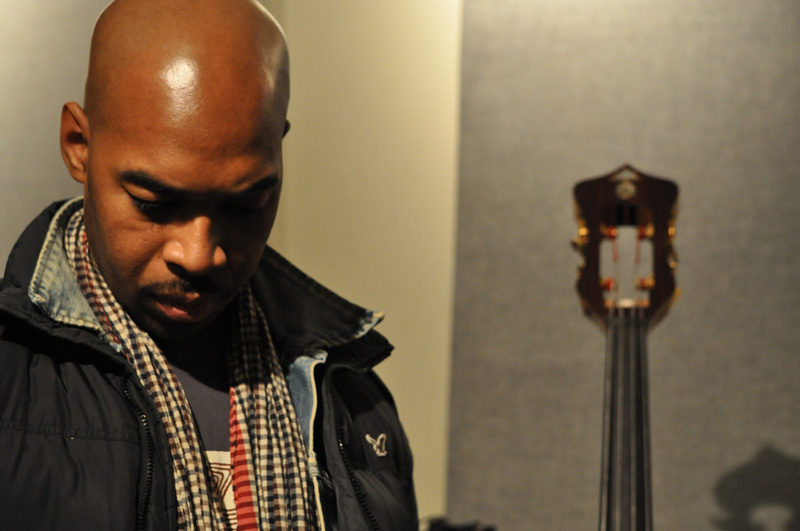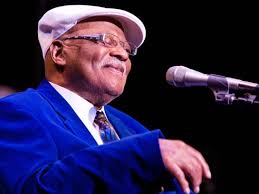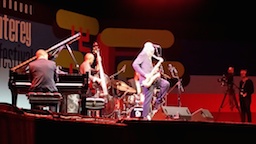Archives
- April 2024
- March 2024
- January 2024
- December 2023
- September 2023
- May 2023
- April 2023
- March 2023
- November 2022
- October 2022
- February 2022
- December 2021
- October 2021
- September 2021
- August 2021
- July 2021
- June 2021
- April 2021
- March 2021
- February 2021
- January 2021
- December 2020
- November 2020
- October 2020
- August 2020
- July 2020
- June 2020
- May 2020
- April 2020
- March 2020
- February 2020
- January 2020
- December 2019
- November 2019
- September 2019
- August 2019
- July 2019
- May 2019
- April 2019
- March 2019
- February 2019
- January 2019
- December 2018
- November 2018
- October 2018
- September 2018
- August 2018
- July 2018
- May 2018
- April 2018
- March 2018
- February 2018
- January 2018
- November 2017
- October 2017
- September 2017
- August 2017
- June 2017
- May 2017
- April 2017
- March 2017
- February 2017
- January 2017
- December 2016
- November 2016
- October 2016
- September 2016
- August 2016
- July 2016
- June 2016
- May 2016
- April 2016
- March 2016
- February 2016
- January 2016
- December 2015
- November 2015
- October 2015
- September 2015
- August 2015
- July 2015
- June 2015
- May 2015
- April 2015
- March 2015
- February 2015
- January 2015
- December 2014
- November 2014
- October 2014
- September 2014
- August 2014
- July 2014
- June 2014
- May 2014
- April 2014
- March 2014
- February 2014
- January 2014
- December 2013
- November 2013
- October 2013
- September 2013
- August 2013
- July 2013
- June 2013
- May 2013
- April 2013
- March 2013
- February 2013
- January 2013
- December 2012
- November 2012
- October 2012
- September 2012
- August 2012
- July 2012
- June 2012
- May 2012
- April 2012
- March 2012
- February 2012
- January 2012
- December 2011
- November 2011
- October 2011
- September 2011
- August 2011
- July 2011
- June 2011
- May 2011
- April 2011
- March 2011
- February 2011
- January 2011
- December 2010
- November 2010
- October 2010
- September 2010
- August 2010
- July 2010
- June 2010
- May 2010
- April 2010
- March 2010
- February 2010
- January 2010
- December 2009
- November 2009
- October 2009
- September 2009
- August 2009
- July 2009
- June 2009
- May 2009
- April 2009
- March 2009
- February 2009
- January 2009
- December 2008
- November 2008
- October 2008
- August 2008
- July 2008
- June 2008
- May 2008
- April 2008
- March 2008
- February 2008
- January 2008
- December 2007
- November 2007
- July 2007
Categories
- Ain't But a Few of Us (2)
- Artist's P.O.V. (32)
- Book Review (4)
- CD REVIEWS (1)
- Crate Digging (5)
- Events (2)
- General Discussion (522)
- Indy Record Company P.O.V. (4)
- Jazz Ed (2)
- NEA Jazz Masters (1)
- Playlists (27)
- Radio (3)
- Records (25)
- Release (1)
- Songs (2)
- SoundViews (1)
- Tech Side (1)
- That's What They Heard (13)
- The Audience (3)
- The Presenter's P.O.V. (15)
- The Tip (8)
- Video (1)
- Weston Chronicles (2)
- Wondering Aloud (2)
Blogroll
The Independent Ear
Eric Harland restless Voyager
As the 2014 Monterey Jazz Festival Artist-In-Residence (check the September ’14 Archives for our report on MJF), drummer Eric Harland was quite literally everywhere. Over the course of that weekend he performed five times, including twice with his own band Voyager, twice with Charles Lloyd (Sangam with percussionist Zakir Hussain and as part of the master’s quartet), and with MJF’s high school all-star Next Generation Jazz Orchestra. At 36 Harland is part of a remarkable generation of musicians to have impacted the scene after arriving from Houston over the last decade or so; a group which includes pianists Jason Moran, Robert Glasper, and Helen Sung, fellow drummer Kendrick Scott, and tenor man Walter Smith 111 (who is also a member of Eric’s Voyager band), just to name a few. Since his arrival Harland has made over 200 record dates and performed with several NEA Jazz Masters, including ancestors Betty Carter and Joe Henderson, and newly-minted 2015 NEAJM Charles Lloyd. Clearly some questions were in order for one of the busiest drummers on the current scene.
Your new record is Vipassana; talk about that title and is the title in direct thematic relation to the compositions on the record?
I got the title Vipassana from the actual Vipassana meditation that means “know thyself”. This “know thyself” meditation practice is in reference to understanding that external situations do not have to affect your state of being. Basically when things occur you do have a choice of how to react. Vipassana’s title is in direct thematic relation to the album. I desired that all the songs and overall vibe of the album should in someway reflect what I felt in my meditation of Vipassana.
I find it interesting in light of often witnessing drummers – including some of the masters, like Max Roach and Elvin Jones – make recordings as leaders that do not include chording instruments in their bands. For Vipassana you’ve chosen to have not only piano/keyboards, but also two guitarists in your band for this record. Explain how this particular configuration best served your vision for this record.
I love chordal instruments. They allow me a chance to hear life in a harmonic way. Also with them being chordal, they provide a more ambient setting which allows the rhythm to be more present. But to explain how this pairing of guitarist/pianist serves my vision… Well they each have their own sound and can play multiple notes at once, allowing for more of a range of sound and texture… which is definitely what I was hearing for this album.
From all of your many experiences, including SF Jazz Collective, the Charles Lloyd Quartet and so many others, what did those experiences teach you in terms of making your own record?
Those experiences helped me to see clearer that I actually had something that I wanted to say musically via my own album. Also by working with great masters like Charles Lloyd, Dave Holland, Zakir Hussain and many others, it naturally blessed my ideas in ways even I wouldn’t have imagined.
ERIC HARLAND AS DRUM EDUCATOR
You had to be about the busiest musician on the festival at the recent Monterey Jazz Festival – playing two sets with Charles Lloyd under different instrumental circumstances, playing two gigs with your own band Voyager, and playing with the Next Generation Jazz Orchestra high school all-stars, etc. What was that weekend like for you?
That weekend was simply amazing. I was actually “Artist in Residence” which was an honor, giving me an experience to work with the kids and see how inspired they were by music. Another highlight for me was definitely being able to debut the Voyager band. But yes, the weekend was non-stop… moving from stage to stage performing completely different material from the other, being approached by a multitude of fans with questions, making sure you remember to eat, checking in on other fabulous bands and having chance to see all my friends and family in one place.
At the Blue Note @ 75 panel discussion Robert Glasper talked about all the musicians who went to that same high school in Houston. What was that high school creative environment like and how have so many of you risen to prominence?
Yes, that high school was definitely a chance to spend time (not only with other exciting artist) but with your own craft as well. It was actually encouraged. That program proved to me that when you are supported so early on in your development, it just gives you more time to express/discover yourself to an even higher level… which is clearly seen by the success of HSPVA’s alumni.
What have you got planned next?
I’m an Artist, I don’t plan… I create. So what I’m working on now is:
1) I’m one of the new SFJAZZ resident Artistic Directors for 2014-2016 seasons. People can tune in there to see what exciting things I’ll be doing at SFJAZZ.org
2) JamesFarm’s new album is coming out this month. That band consist of Joshua Redman, Matt Penman, Aaron Parks and me.
3) PRISM, a band including Dave Holland, Kevin Eubanks, Craig Taborn and me are getting ready to record our 2nd album.
4) I have a new album that I’m currently working on 🙂
5) and as always, on tour…
Charles Lloyd Quartet
JamesFarm
Sangam
Aaron Goldberg Trio
Voyager
Dave Holland PRISM
and more.
You can checkout my schedule via my website ericharland.com
Also you can follow/like me on Twitter, Facebook and Instagram
Posted in General Discussion
Leave a comment
Definition of a true mentor
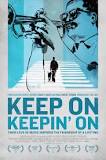
After hearing nothing but great things about the documentary film “Keep on Keepin’ On,” including a ‘you MUST see this film’ order from Christian McBride‘s Twitter feed, I got an email invitation to a screening of the film at the AFI Theater in Silver Spring, MD. On an inviting fall Saturday afternoon what a distinct pleasure it was to spend those 84 minutes with this lovely film! “Keep on Keepin’ On” is a truly wonderful film and an abject lesson in mentoring young people.
Based on the warm and loving relationship between NEA Jazz Master Clark Terry, one of the purest spirits this music has ever produced, and the aspiring young pianist Justin Kauflin, “Keep on Keepin’ On” is equal parts love letter to jazz, tribute to CT, object lesson in the importance of nurturing and mentoring young people, and above all a love letter to the human spirit. Throughout the film, despite his poor and often bed ridden state of health, owing largely to nearly a lifetime of suffering from diabetes, Clark Terry gives love and drops science on a young man who is likely to follow in Clark’s footsteps, as a giving soul and as a significant player. Doubtless education will also become part of young Justin’s future; how could it not after spending so much quality time with one of the pioneers of jazz education!
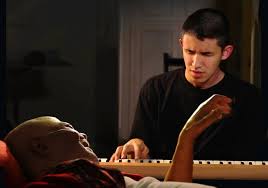
Justin Kauflin playing for Clark
That the film is produced by Quincy Jones, Clark Terry’s first in an endless line of students and mentees, is all the more poignant as Q has in turn taken young Kauflin under his wing and is producing the pianist’s debut recording. The film is also a tribute to the strength and love Gwen Terry shares with her husband. We meet Justin’s parents and learn how a degenerative condition took his eyesight at age 11 and how neither that catharsis nor his ensuing challenges will keep this unusual young man from mastering the jazz piano. And director Alan Hicks, himself a Clark Terry mentee as a drummer, has skillfully woven in exceptional biographical footage of Clark Terry, from his St. Louis roots, through his Count Basie, Duke Ellington, and Tonight Show band triumphs. We hear Clark recounting how a certain churlish old musician purposely gave him false trumpet playing information as a youngster and how CT vowed he would never similarly treat young musicians he would subsequently encounter.
These elements are all satellites orbiting around the film’s core – Clark Terry as giving spirit and mentor supreme. Filmgoers will witness Clark’s troubles with the various infirmities of old age, including not only the loss of his sight but also the amputation of his legs and the very real sadness and resignation of that fate as Clark and Gwen go through medical regimens and eventual capitulation to the ravages of diabetes. Though he pauses to reflect sadly on that loss of mobility, his true spirit of giving is never dampened, never deterred. There is a touching mutuality between CT and Justin as each in his own way is uplifted by the other on so many levels, from their shared vision challenges to the challenges of playing the music in the true spirit of jazz. Throughout the film there are vignettes and testimony lovingly offered by other younger artists Mr. Terry has touched, such as a certain rail thin young trumpeter from East St. Louis, IL who declared Clark Terry his “first idol”, a certain Miles Davis. Dianne Reeves, another student of the master, also extends much love in the film.
Every aspiring musician and parent of aspiring musicians should see this film, it is a triumph of the human spirit of both mentor and student. Here’s a link to the trailer for “Keep On Keepin’ On”. If you see one film this season, you must see “Keep On Keepin’ On”.
http://trailers.apple.com/trailers/independent/keeponkeepinon/
Posted in General Discussion
2 Comments
Matthew Garrison: ShapeShifter in motion
Last July, as chronicled in these pages (check the Archives section for August ’14) this writer had the pleasure of spending a weekend at the New Mexico Jazz Festival for a NEA Jazz Masters site visit on drummer Jack DeJohnette‘s Santa Fe residency. Jack’s visit culminated in a Saturday evening concert featuring his bracing trio, with Ravi Coltrane on saxophones and Matthew Garrison on bass. As many of you likely know Matt Garrison is the son of the late bassist Jimmy Garrison, of John Coltrane Quartet fame. A few hours prior to the evening concert I sat down on the exceedingly pleasant veranda of his Santa Fe hotel for a conversation with Garrison for a downbeat.com feature. Below is the complete Matt Garrison conversation, which ranged broadly from the DeJohnette and Ravi Coltrane connection to Matt’s bass guitar conception, to his burgeoning ShapeShifter Lab enterprise in Brooklyn.
Willard Jenkins: You have a long and deep history with Jack DeJohnette.

Matt Garrison: Absolutely. It started pretty much when I was born, or thereabouts. Jack knew my dad and they performed together on a few occasions. I grew up on the Upper West Side for a little bit and I think Jack was close by, he and his wife were good friends with my mother and my dad.
Eventually what happened, when my father died Jack basically said to my mother “if you ever need help with the kids, [he’d] be willing to help out.” After my dad died we moved to Italy for ten years – in ’77 (I was 7 years old). By the time I hit the age of 17 I actually was given the choice by the Italian government to become an Italian citizen. But in order to do that I would have had to do one year of military service. So I said ‘ya know what, I think it’s time to get the hell out of here…’ [laughs]. So we were trying to think of places to go and we called Jack up and said ‘Jack, remember that thing you said?’ And he said “cool.” So I had one more year of high school to finish and I finished it up in Woodstock and I lived with Jack’s family for a year and it was amazing.
As far as playing with Jack, is this the first tour that you’ve ever done with Jack?
Yeah. It started this year. We did this one event at the Brooklyn Museum, it was fantastic. Anytime I came to Jack’s house after I’d lived there – because I went to Berklee – but every time I came back to Jack’s place we would jam and he would show me some new stuff, he mostly played piano, but he’d play bass too and I’d try to play some drums and piano… it was amazing. That particular [’97 Brooklyn] event, he basically put it together and then he asked me and Ravi to come to his house and we spent two or three days just going through all this music, and that’s another one of the greatest moments of my life. First of all because I had never played with Ravi, so that was our first opportunity to play together.
Did you know Ravi before?
I think I had met him once before.
So the music that you played in Brooklyn that first time, how has it evolved to what it is now?
I guess now I can play it a little better [chuckles]. From what I can remember we played things like “Countdown”, “Giant Steps,” “ Central Park West,” “Spiral,” and some other really critical compositions of John’s. I think I was like 22 or something, so I knew how to play, I was somewhat versatile, but that was some hard shit to play! And at the time, speaking from my perspective as this has evolved, at the time I was playing more just bass function, meaning mostly playing roots and spelling out the chord changes, but I could also solo over the stuff which I guess was kind of important so that we had opportunities for soloing and going through the form and that kind of thing. It was a lot more basic from my perspective.
Now, over the years I’ve developed certain things where I play a lot of chordal information and I also play a lot of melodic information and the bass stuff, so I’m playing a quite specific role. We made a joke about this – Jack was like ‘hey man, you’re covering a lot of territory there, we don’t really need a piano player, sometimes we don’t need a melodic player… just don’t start asking me for more money.’
In this essentially bass-drums-saxophone setting it’s a challenge because there’s no chording instrument.
Yeah, but that’s where I come in. Another component that I bring to this current version is I use a lot of computer based software to enhance the sound or the textures that we use that I can use onstage. It’s a lot of open textural things that can really fill up – it creates a very dramatic texture off of which we can then create more dramatic textures. Its very, very different from what we initially did 20+ years ago from that standpoint. And of course the music – what’s interesting is that we’re not playing so much original material right now, that might just be because we’re just having too much fun playing these compositions by all these great master musicians. We’ve been playing stuff from Monk, Ornette Coleman, Joe Henderson, McCoy Tyner, Duke Ellington… we’re covering a lot of ground. I’m glad that I took the time to learn that material over the years.
Has this unit recorded yet?
We’ve recorded a whole bunch of stuff, but this seems to be one of those projects that kind of needs to be recorded in a live setting. I mean it could work in the studio too.
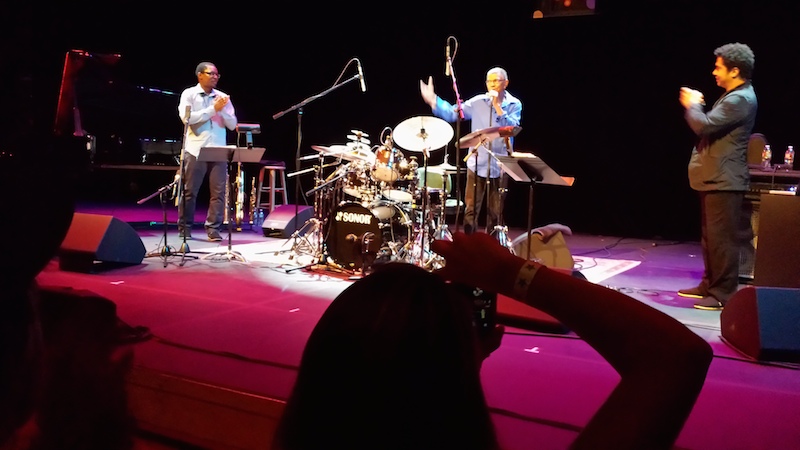
Jack DeJohnette Trio at their New Mexico Jazz Festival performance
So why do you feel it’s better live than it would be recorded in the studio? I ask that also because considering the computer technology you’ve brought into the picture it would seem that might be better served in a studio environment.
Yeah, but I’m using it very differently because I’m using it in a way that its fully integrated into the idea of improvisation. So all the tools that I’m using are part of what can happen right now, there’s a lot of flexibility in that sense. Of course the computer stuff can be used in a very structured, thematic way, but that doesn’t work for this project. I’m taking advantage of another side of it and that’s great for me because I get to explore a whole bunch of other things. But the other thing about how this project works better as a live situation is that it tends to be an arc of information, in terms of drama there is a whole story that needs to be told and it undulates, it moves, it comes in and out with dynamics, and then there’s a lot of wide open improvisation in that whatever happens happens and then we go back into some information that people can relate to and when you get feedback from the audience then you start doing things differently.
The audience presence makes a real difference in this trio’s performance?
Absolutely! When we first started we decided very specifically that we open the show with some really out to lunch shit. So you can already tell the audience is like ‘aw shit…’ [laughs], they start looking at their watches, they’re getting a little bit uncomfortable, and then it slowly gets to something that they like, then we take it out to lunch a little bit more, and then they’re like ‘OK, so maybe that’s not so bad.’ There’s a whole series of things happening and we’re observing this, its fun for us to watch. We did a sound check somewhere in France and there was this old couple sitting in front watching us and we were playing like a Monk tune and then a Miles tune and they were happy checking out the sound check. And then I put on one of my weird computer things and they jumped up [laughs] and Jack started laughing, ‘did you see what you just did.’ But then they came back for the show, we saw that specific couple, and they loved it.
So there’s going to be a record from this trio?
I’m sure of it at some point. It should be a compiled set of recordings.
What is your sense of the irony of being on this tour with Ravi Coltrane in terms of both your ancestral lineage?
Well, I think its been long overdue and I don’t think there’s a better situation for it to happen because Jack is kind of like the unifying energy. If I really consider my musical beginnings, he’s it, he’s my sensei. I don’t know if he and Ravi have had the same sense of development but I’m sure they’ve had their moments to work over the years; Ravi has played in Jack’s groups and they’ve done other projects for other folks, and Ravi and I have done other projects, little things here and there.
I was asked to come play with McCoy [Tyner] at some point and I think Ravi was on that, but McCoy wanted me to play acoustic bass and I couldn’t do it. I didn’t want to sound like an idiot because that’s not my instrument. Maybe to some degree I should have studied it a little bit more but I put a lot of energy into [bass guitar] and I want that to be the focus. So when you’re playing with those masters and those historical figures, If I would have been allowed to play my instrument I’m sure Ravi and I would have been very comfortable to play some of the music that his father put together, or McCoy’s music. We’ve been invited to play other projects where they want us to play John Coltrane’s music and they want very specific types of things and we’ve both refused because its too sensitive.

Not only is it too sensitive, but here it is the 21st century and you guys have evolved your own way of playing, so I don’t imagine a kind of repertory project appeals to you.
Right, and that’s very much part of why we’ve both avoided those situations. But in this [DeJohnette Trio] context… think about the fact that Jack did play with both of our dads and Jack definitely pushed me to learn that music over the years. When I first got up to his house he said ‘hey man, check this record out, see you later… come back and I’ll give you another one.’
I opened a venue in Brooklyn called ShapeShifter Lab and Ravi has been instrumental in helping the place do well. There was a period where we had this real rinky-dink piano and that’s a problem in New York because if you want some serious cats to play there you’ve gotta have a good piano, so he donated a piano to the space, and he helps in different ways. Now we’re opening up a non-profit side of the business and he’s going to help, he’s already on the board of directors – Jack is going to be involved in that as well.
You mentioned McCoy and your decision to stick with the bass guitar, at what point did you determine to specialize in the bass guitar?
Probably around then [chuckles]. It was much sooner than that. Actually when I was in Italy I did start studying bass. I got my first bass, which was an electric bass, at 14 or 15 and then it was recommended by various Italian musicians that I really had to get some kind of foundation in classical music which could then help me out in my jazz education as well. So then I went and studied a little bit of classical acoustic bass. The main problem that I had with that is that the school was quite far from where I lived and I had to take a train out there and I was this young black man with an afro with an acoustic bass in a big red case and I was on this train in Italy going to the school and you know how Italians are, they like to just stare at people. So I was on this train and people were just staring at me, so when I was 15 I was already getting quite irked by the acoustic bass thing. So that’s one of the first things that kinda got to me, so I said let me stick with [bass guitar], it’s smaller and easier to get around with. And then of course I started listening to cats like Stanley Clarke, Marcus Miller and Jaco and thinking ‘oh my gosh, this thing is like wide open’, and I didn’t necessarily see that opportunity with an acoustic instrument. My tendency has actually been a little bit more towards electricity in general and it just gives you more options.
Now as technology has moved, especially from a software standpoint, its basically a golden age that unfortunately a lot of musicians that deal with improvisations still don’t know. There’s so much that can be done it’s scary. I bought my first computer in 1996 and I’ve never stopped; I’ve been recording and experimenting and trying things out. As technology gets better there’s more things you can do onstage now and it’s much smaller. I have a laptop, a little audio interface, a little pedal, one other pedal, some cables and the bass… and it’s done. The things you can do with just that set-up is sick; and this is just a stereo presentation because I also do surround sound presentations with that, which is a completely different world; I hope we can do that with Jack one day.
Is it your sense that specializing in the bass guitar has opened up more diverse opportunities for you?
Absolutely. If I had studied acoustic bass I think I would have had maybe two or three types of recording and performing options – one in the classical world, one in the more experimental jazz/improvisational world… not many other places to go with that instrument. And also now consider what’s happening with the airlines and how cats like Dave Holland, John Pattitucci, Ron Carter… and what they have to go through. With the electric bass I have a wide array of genres I could tackle which gives me the opportunity to have more financial potential and if you have finances now you have more opportunities to try some more things – going from pop to funk to jazz, and to be able to do them all is an important thing.
Aren’t they making advances in more portable acoustic basses, like Dave Holland’s instrument?
Yes and Dave’s bass sounds incredible.
Talk about Garrison Jazz Productions and your various business enterprises.
Garrison Jazz Productions is slowly being absorbed. Me and my business partner Fortuna Sung, an old high school friend of mine from when I was living in Italy, we met again after many years when I was on tour with Whitney Houston and she was in Tokyo at the same time we talked about this vision that we both had and we decided to just go for it. The first thing we did was we opened a new production company called ShapeShifter Productions and the second one which is called SSP Holdings – which is related to everything involved with music production, management, we have a whole set of items that we take care of there.
ShapeShifter… sounds like there’s some philosophical aspect to that name itself.
Yeah, the idea is definitely why be limited to one thing when you can do many things, and I think maybe in a way my particular history as a human being kind of reflects that – I’ve got parents from two very specific backgrounds, if you want to talk about race that’s part of the equation, if you want to talk about hierarchy and societal positioning of things… my mother is also Jewish, so that adds another component to this thing. I grew up in Italy and I started playing classical, I play jazz, I play funk, I play pop… and so why not?
I made a record which is called “Shapeshifter” and I said look, I’m not going to be stopped by anything or anybody, why should I? You only live once, if you have some ideas put them out. That was the original intention of Garrison Jazz Productions, to just basically create any music I want to, without limitations, I own everything. And that’s how it still stands – I own all publishing, all copyright, and any future options.
Describe ShapeShifter Lab.
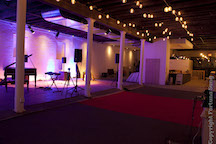

Altogether it’s a 4200 square foot location, so it’s quite big. The main space where all the performances take place and all the events is 3600 square feet, which by Brooklyn standards is quite large for the type of music we’re putting on there. Its in Gowanus, near the canal about two blocks up – between Carroll and First, at the bottom of Park Slope. First of all I don’t want to stop musicians from performing at our space because they don’t fit a certain criteria of musical expression. So we pretty much let everyone play there. If you’re really at the beginning of your career we have other things they can do, certain events that are not like an actual professional situation because of course what’s gonna happen if people aren’t known and if they’re not very well informed on their instruments there’s not going to be anybody there, unless they have a party. I curate the space but we do have people that we give them carte blanche to do whatever they want and that’s also been quite incredible because I can’t really have that many ideas and the ones that I do have aren’t necessarily the most successful ones so its also important to bring in some other folks that are basically putting together whatever vision they have. Its been incredible for all of us.
How many nights a week are you open?
Seven, we’re going to try to back that down a bit through the use of the non-profit because its getting a little hard on the staff, which depending upon the events could be up to eight.
Who are some of the people who’ve played there regularly?
Aaron Parks, Andy Milne plays there a lot, Gene Lake with his various projects, David Gilmore – he had his 50th birthday celebration there and we had to send people away there were so many! Ravi plays there pretty frequently; a lot of folks from the avant garde community, Glasper has played there more as a guest but he just recently had his kid’s birthday celebration there, Jason Moran came down… that’s the thing that happens in the space, it feels like a family kind of thing, and it is because its all of us and we’re just doing it. And then when Jack shows up everybody comes down and it’s this big party. In a way it’s this hidden revolution that’s happening. We’re getting press and the folks that do know they get it. You walk in and it’s like a big old open living room, with a little more detail. We do have a bar in there, a beer & wine license.
That’s a full-time pursuit itself, how do you manage to do that and your music?
I have no idea, but it’s working. Going on tour right now like this is a vacation! I have to say that without Fortuna there’s no way in hell this would work because she’s doing a lot of the paperwork. What we’ll be able to do through the non-profit is that we’ll be able to implement a lot of the ideas that we’ve had without the for-profit business always going into our pockets to make these creative ventures a reality. If you really break it down, if we were only to base our business on presenting performances we would already be closed. So everything else that happens at the space – which tends to be rentals, corporate events, weddings, recitals, bar mitzvahs… Now we have a pretty vast clientele coming through the place. So we don’t want to keep taking the resources from the for-profit to then keep the arts alive when it could be done through a non-profit, which is not associated with ShapeShifter Lab itself.
I have some major projects that I need to do that I can do as a for-profit, but others that involve a larger scope of musicians… At the space, the artists come in, they create this cool little hip scene, then some folks around the neighborhood want to poke their heads in and see what’s going on, they love it and now they want to have their parties there, now they want to do this… then you start seeing actors come in and people with a lot of money. We’re already doing everything a non-profit does, but it works. It’s a good development. There’s a lot of educational events going on there. We’re building education into our non-profit side.
I’ll be able to release at least two new projects of mine before the end of the year, and one of those is more of a complete open improv project with various folks that I’ve observed at ShapeShifter Lab that just blew my mind because they were just so out to lunch, but in a really interesting and captivating way; so I want to collaborate with those folks. And then I have a very interesting project where I finally decided to do a fully electronic project, where I’m not even playing the bass; that’s pretty much done – me and a computer and some interesting lighting projections.
Two other projects I have to get done are a big band project with some of my older tunes that I have to rearrange for 18-19 piece big band – we’ve actually performed that several times but I need at least three more charts. The project after that is a fully acoustic project with an acoustic bass guitar – I might even play a bit of acoustic bass and acoustic guitar; that will be some material I still have to write for that project specifically. I’ve got a lot to do.
See the Jack DeJohnette Trio with Matthew Garrison & Ravi Coltrane in action at the Montreal Jazz Festival:
Posted in General Discussion
Leave a comment
Monterey stronger than ever @ 57
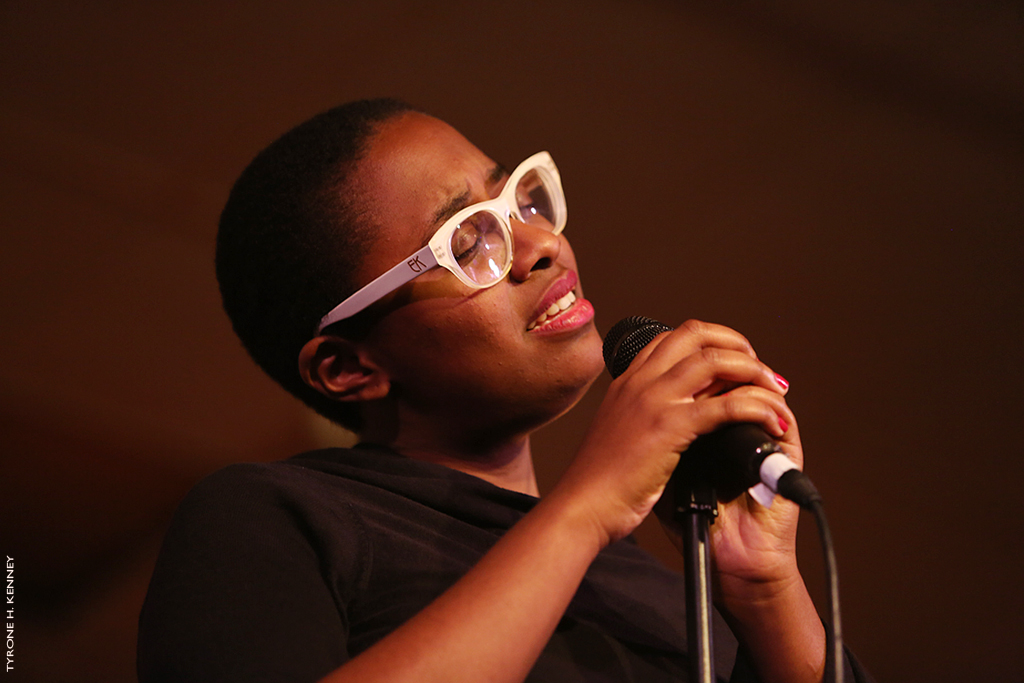
Songbird Cecile McLorin Salvant keeps racking up the fans wherever she goes – shown here at one of her two MJF ’14 performances (photo: Tyrone Kenney/NeoBop Project)
Last weekend’s Monterey Jazz Festival was yet another reason the event remains one of the art form’s true standard bearers. Across the six stages on the Monterey Fairgrounds one could experience past, present and future over the course of three days, including several hybridized shades, and the sense of interconnectedness was quite palpable. Let’s start with Friday evening on the Jimmy Lyons Stage in the Arena (the big stage) with Cecile McLorin Salvant, who at the tender age of 24 continues to distinguish with her big, expansive voice that ranges from coquettish to astounding high & low register displays and her yen for older songs. Her essential piano accompanist, Aaron Diehl, distinguished himself with two separate performances of his MJQ revisited with the estimable vibist Warren Wolf in the Bags seat. Cecile was followed on the Lyons Stage by the Robert Glasper Experiment, whose set was hampered by some keyboard tech peccadilloes. But Glasper showed up quite auspiciously on two succeeding occasions – first as a panelist on the very rewarding talk session (or “spoken word” session as friend & colleague moderator Ashley Kahn characterized it) celebrating Blue Note Records 75th anniversary, with fellow panelists NEA Jazz Master Bobby Hutcherson and label prexy Don Was. Later that afternoon Glasper was pianist in the One Point of View Blue Note futures band, with trumpeter Ambrose Akinmusire, guitarist Lionel Loueke, tenor man Marcus Strickland, bassist Derek Hodge (also in Glasper’s Experiment), and the resourceful drummer Kendrick Scott. Loueke also hit with Herbie Hancock who closed Friday’s auspicious Lyons Stage lineup. And Akinmusire played his own quintet set Sunday evening at the Nightclub.
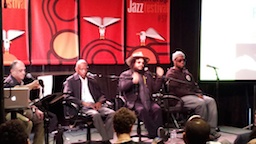
The Blue Note @ 75 panel: L to R moderator Ashley Kahn, Bobby Hutcherson, Don Was, Robert Glasper
That sense of interconnected artists was a hallmark of this year’s event and a testament to MJF artistic director Tim Jackson’s sterling programming acumen. Many of these artists reside in the NYC area so just flying them all to Cali is such a potential budget buster that engaging the more multi-faceted among them for more than one gig just makes sense. Jason Moran was another example; playing his Fats Waller Dance Party on the Garden Stage, trumpeter Leron Thomas delivering a pithy take on Waller’s “Two Sleepy People”, to open Saturday’s evening session in celebration of the release last week of that project’s Blue Note document All Rise. Then Sunday evening he hit with the Charles Lloyd Quartet (more on him later) in the Arena. The ever-burning, undersung piano great Harold Mabern played three sets at the Coffee House on Friday evening then hung out the rest of the weekend. The festival’s HQ hotel is the Hyatt and the late night jam sessions there are always a good hang to connect with friends and colleagues. Such was the case when some friends summoned Suz and I to the Hyatt lounge on Saturday evening. The usual band of students and occasional pros were cooking while we were busy yukking and catching up with friends in one corner. When the band struck “My Favorite Things” there was a perceptible deepening of the piano groove & acumen that caused heads to turn. Sure enough Mabern had eased into the keys and it was on!
Drummer Eric Harland, this year’s artist in residence, guested with the MJF Next Generation high school all-stars to open the Sunday matinee on the Lyons Stage, played two gigs with his Voyager band, and burned brightly with the Charles Lloyd Quartet on Sunday night. Christian McBride swung with virtuosity at the helm of his trio (Ulysses Owens on drums and Christian Sands on piano) on the Nightclub stage Friday evening, and grooved with equal depth as part of the Philadelphia Experiment, with drummer Ahmir “Questlove” Thompson (who later that evening led The Roots on the Lyons Stage) and keyboardist Uri Caine. They were joined for some closing selections (including an obligatory “Green Onions”) by B-3 funkmeister Booker T. Jones, who’d played the Saturday matinee on the Lyons Stage with his own band.
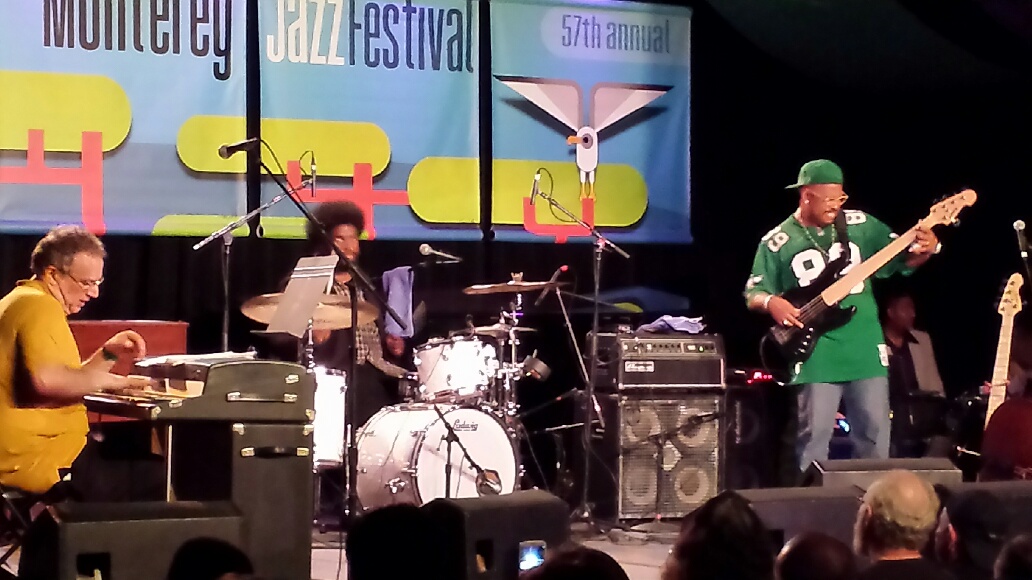
The Philadelphia Experiment: L to R Uri Caine, Questlove, Christian McBride
Freshly minted NEA Jazz Master Charles Lloyd (just signed to Blue Note per Was on the aforementioned panel session) was a featured MJF eminence, playing in different contexts each of the three nights. On Friday evening he played a beautiful, meditatively spiritual set with Sangam, his trio with master Indian percussionist Zakir Hussain and Harland (mama, there goes that drummer again!). Saturday evening brought arguably the highlight of Lloyd’s three performances – an incandescent duo hit with pianist Gerald Clayton at Dizzy’s Den, one of the festival’s real beauty spots. Sunday evening Lloyd brilliantly celebrated the spirit of his 1966 Monterey breakthrough by including an obligatory “Forest Flower” on the Lyons Stage with his Quartet (Moran, Harland and bassist Ruben Rogers). The festival also screened Charles’ rewarding new ECM film “Arrows Into Infinity” in the Theater. There were additional interconnections, those are just the ones this writer was able to experience!
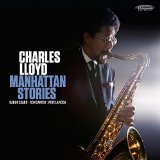
Lloyd’s latest release is a live document that journeys back in time to his 60s days leading a piano-less quartet
Additional Highlights

Melissa Aldana was a tenor revelation for many
Tenorist Melissa Aldana and her rich, burgundy tone certainly garnered some new fans with her fine introductory set before a modest but deeply appreciative audience on the Garden Stage. Even at this early stage of her evolution one can envision potential greatness from this assured-though-humble young Chilean saxophonist. Aldana is indeed a lovely young woman, but clearly not one prone to succumb to the gratuitous sexuality of a Candy Dulfer, or heaven-forbid the self-declared “Saxtress” Pamela Williams; Ms. Aldana thankfully is all about the music. Jazz festivals should also be about some fun, right? Well the Brooklyn-based Red Baraat and its oft-humorous mix of improvisatory bangra certainly delivered in that department, as attested to by all ages beckoned to their dancing feet by the groove. The aptly-named Our Point of View clearly demonstrated the Blue Note label’s keen eye on jazz future, opening with a reimagined “Speak No Evil”, playing the label classic through their 21st century lens. Apropos they followed that up with Marcus Strickland’s ferocious original “Tick Tock.” On “Bayyinah”, a Lionel Loueke original from his latest release Heritage, the guitarist played an opening cadenza that uncannily invoked talking drum patterns on his instrument!
There was a lovely kind of wistful optimism in the Brian Blade Fellowship’s expressions of originality, coupled with the controlled flames of Melvin Butler‘s tenor and Myron Walden‘s alto saxophones. After having lent an exquisitely burnished trumpet cadenza to one of his originals on the Our Point of View set, the next day MJF Next Gen alum Ambrose Akinmusire evidenced exponential growth in both his sound and his quintet band concept on the Night Club stage Sunday evening opener. Drummer Justin Brown provided ample explosion for the quintet and tenor saxophonist Walter Smith (who’ll almost certainly be an MJF bandleader on his own very soon) proved an apt alternate solo voice in the ensemble. Vocalist Becca Stevens, whose own set we missed, brought a very attractive quiver to her guest turn with Ambrose. Akinmusire has even at this early stage in his evolution acquired a keen sense of editing both himself and his band, never overplaying. And that’s just a summation of what we caught at MJF; reportedly some of what we missed would be enough to populate a successful jazz festival! But you can’t make ’em all; in more youthful times I might have tried, but there was never a set where this writer found himself yearning to be elsewhere, despite the fact that “elsewhere” was a ton of reportedly essential music. Yes folks, that is indeed the beauty of a great event like the Monterey Jazz Festival!
Cuisine Tip
Besides the obvious charms of the festival, the Monterey Peninsula is a recommended destination in and of itself, and after all these years there remain many undiscovered culinary gems. Good friends turned us on to an essential new stop to get the feed going. Phil’s Fish Market, on Moss Landing just north of Monterey was the cuisine discovery of this trip. One of those “rustic”, no reservations dockside joints where you order at the cash register then find your spot either inside or out on the beach at picnic tables, the house specialty is their cioppino, a luscious, tomato-based traditional Italian shellfish stew served in different permutations, in either prodigious individual bowls or family-style. And the breaded & grilled sanddabs are worth the trip alone, as is the calamari and the several varieties of artichoke preparation.

Posted in General Discussion
Leave a comment

